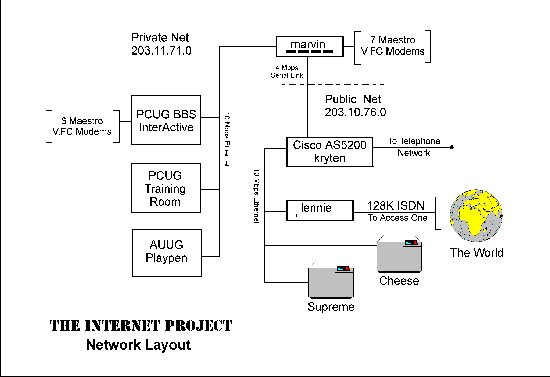

On the first of October, 527 TIP accounts were suspended for not signing the Acceptable Use Policy declaration. Since then, approximately 50 have been unsuspended. If you are still suspended, and wish to be reinstated, then rock on down to the PCUG Centre at Northpoint Plaza any weekend (except long ones) between 9am and 5pm or Monday, Wednesday, Friday between 10 am and 2pm and sign a Declaration. Your account should be reinstated within the week.
On the other hand, if you have decided to let your TIP account lapse for any reason, we would really appreciate it if you could let us know so that we can clean up some old accounts. Important News!
By the time you read this, TIP will have relocated (with any luck) to the new centre at Northpoint Plaza - it will be in the room down the back (no, not in the toilet). Thus everyone will need to reconfigure their dialler software to connect to the new number for TIP. By the way, the number is now:
Here are the instructions for Trumpet Winsock (Windows 3.x) and for Dial-Up Networking (Windows 95). Those of you using Macintosh, OS/2, Linux, CP/M or MVS/XA will have to work it out.
Trumpet Winsock
Windows 95 DUN
Why doesn't this number follow the pattern of the other PCUG numbers at Belconnen?
As part of the relocation, the PCUG invested in upgraded routing and access hardware - a Cisco AS5200 Universal Access Server. This device provides basic routing functionality between the Public and Private networks of TIP, as well as dial-in services for TIP users using ISDN technology (see diagram).

The AS5200 provides up to 60 in-bound lines, initially 48 due to hardware delivery issues. Instead of 60 standard Telstra phones lines being required (as is the case with the equipment used up until now), only two Primary Rate Interfaces (Macrolinks) are used. The modems will initially be V.34 digital modems.
The benefits that we will achieve from this hardware upgrade include:
Whew. That's the official line, but what does it mean? ISDN can be thought of as a fully digital version of the original, traditional, pervasive public telephone network (PSTN). Both are circuit-switched networks (i.e. calls are made, and a circuit established through the carrier's network and maintained for the duration of the call). Both use the same numbering scheme - and this means that normal telephone (and fax or modem) calls can be made from one network to the other.
However, ISDN is delivered on a multiplexed connection - either 2 B Channels (64 kbit/s 'user' channels) or 30 B channels. The former is termed a Basic Rate Interface and called Microlink by Telstra, and the latter is termed a Primary Rate Interface and called a Macrolink by Telstra. In the U.S. a PRI only has 48 B channels. The 64 kbit/s chunks are derived from the basic building block of all public telecommunications networks - a single digitised voice circuit.
Compare the following: A Microlink can be installed in your home on two pairs of standard telephone cable (four copper wires - standard for most homes) and will provide up to 128 kbit/s of data transmission, OR a single telephone call at the same time as 64 kbit/s of data (with the right equipment). A normal telephone line uses only one pair of wires but can only provide EITHER a single telephone call OR a data connection of up to 38.4 kbit/s real data transmission. This is one of the benefits of a digital network. The main reason that ISDN is not more widespread throughout the consumer market is Telstra's pricing regime :-( Business and Government have been big users of ISDN in this country.
I could go on. Maybe another time.
But didn't I say that there will be no analog connection to TIP with the AS5200? (Note here: AUUG dial-ins to TIP will remain on the previous modem technology and equipment) A fully digital modem still modulates and demodulates data but using a digitally-coded carrier.
Public telecommunications networks use a technique called Pulse Code Modulation (PCM) that converts a standard voice analog waveform into a 64 kbit/s digital stream. As this is a global 'standard', it is possible to act on this digital stream as if it were a true analog signal. Thus the digital modems do their work (and can detect) an analog wave coded into the digital ISDN channel.
If you have any more questions on any of the above, feel free to email me. Catch ya next time.
 Back to Nov 1996 Index
Back to Nov 1996 Index